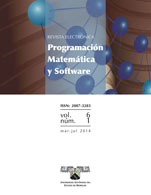Artificial neural network to predict the chemical composition-dependence of stacking fault energy in austenitic stainless steels |
||
 |
Publicación: |
Programación Matemática y Software |
Artificial neural network to predict the chemical composition-dependence of stacking fault energy in austenitic stainless steels |
||
 |
Publicación: |
Programación Matemática y Software |
Alfonso M. Román2, Bernardo Campillo2,3, Arturo Molina1, Horacio Martínez2, Itzel Reyes3, Osvaldo Flores2 |
1Centro de Investigación en Ingeniería y Ciencias Aplicadas, UAEM, México. |
Recibido: 25 de mayo de 2018 Aceptado: 2 de marzo de 2020 Publicado en línea: 30 de junio de 2020 |
Abstract. Stacking fault energy (SFE) is an important parameter to be considered in the design of austenitic stainless steels (SS) due to its influence on magnetic susceptibility, atomic order changes and intergranular corrosion resistance. An extensive review of specialized literature was examined in order to understand the different methods that have been developed for the calculation of SFE. Characterization by transmission electron microscopy (TEM), linear expressions from data processing and first-principles quantum mechanics approximations are some techniques that have been used for the calculation of SFE. In the present work a feed forward backpropagation artificial neural network (ANN) was developed to predict the SFE within given specific ranges of chemical compositions for austenitic SS. The experimental data were extracted from a research work reported by Yonezawa et al [1], and then were analyzed for three different heat treatment conditions. The present model predicts SFE values with a correlation coefficient of 0.99, which is a minor error when is compared with other works in the literature. |
Keywords: Artificial Neural network, stacking fault energy, austenitic stainless steel. |
Resumen. Stacking fault energy (SFE) is an important parameter to be considered in the design of austenitic stainless steels (SS) due to its influence on magnetic susceptibility, atomic order changes and intergranular corrosion resistance. An extensive review of specialized literature was examined in order to understand the different methods that have been developed for the calculation of SFE. Characterization by transmission electron microscopy (TEM), linear expressions from data processing and first-principles quantum mechanics approximations are some techniques that have been used for the calculation of SFE. In the present work a feed forward backpropagation artificial neural network (ANN) was developed to predict the SFE within given specific ranges of chemical compositions for austenitic SS. The experimental data were extracted from a research work reported by Yonezawa et al [1], and then were analyzed for three different heat treatment conditions. The present model predicts SFE values with a correlation coefficient of 0.99, which is a minor error when is compared with other works in the literature. |
Palabras Clave: Artificial Neural network, stacking fault energy, austenitic stainless steel. |
|
| Emails:alfonso.romans@uaem.edu.mx, amrsroman@icf.unam.mx |